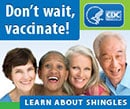Shingrix Recommendations
For the recommendations of the Advisory Committee on Immunization Practices (ACIP), see Shingrix (recombinant zoster vaccine) Recommendations
Summary of Recommendations
Routine Vaccination of People 50 Years Old and Older
CDC recommends Shingrix (recombinant zoster vaccine, or RZV) for the prevention of herpes zoster (shingles) and related complications. CDC recommends two doses of Shingrix separated by 2 to 6 months for immunocompetent adults aged 50 years and older:
- Whether or not they report a prior episode of herpes zoster.
- Whether or not they report a prior dose of Zostavax, a shingles vaccine that is no longer available for use in the United States.
- It is not necessary to screen, either verbally or by laboratory serology, for evidence of prior varicella.
Recombinant and adjuvanted vaccines, such as Shingrix, can be administered concomitantly, at different anatomic sites, with other adult vaccines, including COVID-19 vaccines. Coadministration of RZV with adjuvanted influenza vaccine (Fluad) and COVID-19 vaccines is being studied.
Vaccination of Immunocompromised Adults 19 Years and Older
CDC recommends two doses of RZV for the prevention of shingles and related complications in adults aged ≥19 years who are or will be immunodeficient or immunosuppressed because of disease or therapy. The second dose of RZV should typically be given 2–6 months after the first. However, for persons who are or will be immunodeficient or immunosuppressed and who would benefit from completing the series in a shorter period, the second dose can be administered 1–2 months after the first. For more detailed clinical guidance see www.cdc.gov/vaccines/vpd/shingles/hcp/immunocompromised-adults.html.
Timing Considerations for Giving Shingrix
For patients who previously had herpes zoster
There is no specific amount of time you need to wait before administering Shingrix to patients who have had herpes zoster. However, you should not give Shingrix to patients who are experiencing an acute episode of herpes zoster.
For patients who previously received Zostavax
Zostavax is no longer available for use in the United States, as of November 18, 2020. Consider the patient’s age and when he or she received Zostavax to determine when to vaccinate with Shingrix. Studies examined the safety of Shingrix vaccination 5 or more years after Zostavax vaccination. Shorter intervals were not studied, but there are no theoretical or data concerns to indicate that Shingrix would be less safe or effective if administered less than 5 years after a patient received Zostavax.
You may consider an interval shorter than 5 years between Zostavax and Shingrix based on the age at which the patient received Zostavax. Differences in efficacy between Shingrix and Zostavax are most pronounced among older patients. Studies have shown that the effectiveness of Zostavax wanes substantially over time, leaving recipients with reduced protection against herpes zoster. For example, the vaccine efficacy among adults aged 70 to 79 years and adults aged 80 years and older is 41% and 18%, respectively, on average during the first 3 years following Zostavax vaccination.
You should wait at least 8 weeks after a patient received Zostavax to administer Shingrix.
For patients who do not report a prior episode of varicella
When vaccinating immunocompetent adults aged 50 years and older, there is no need to screen for a history of varicella (chickenpox) or to conduct laboratory testing for serologic evidence of prior varicella. More than 99% of adults aged 50 years and older worldwide have been exposed to varicella-zoster virus, and the Advisory Committee on Immunization Practices (ACIP) considers people born in the United States prior to 1980 immune to varicella. Therefore, even if a person does not recall having chickenpox, serologic testing for varicella immunity is not recommended. It is often a barrier to herpes zoster vaccination, and false negatives are common. However, if serologic evidence of varicella susceptibility becomes available to the healthcare provider, providers should follow ACIP guidelines for varicella vaccination. Shingrix has not been evaluated in persons who are seronegative to varicella, and it is not indicated for the prevention of varicella.
For adults 19 years of age and older who are or will be immunocompromised, see www.cdc.gov/vaccines/vpd/shingles/hcp/immunocompromised-adults.html.
Contraindications and Precautions for Herpes Zoster Vaccination
Shingrix should not be administered to:
- A person with a history of severe allergic reaction, such as anaphylaxis, to any component of this vaccine.
- A person experiencing an acute episode of herpes zoster. Shingrix is not a treatment for herpes zoster or postherpetic neuralgia (PHN). The general guidance for any vaccine is to wait until the acute stage of the illness is over and symptoms abate.
There is currently no CDC recommendation for Shingrix use in pregnancy; therefore, providers should consider delaying vaccination until after pregnancy. There is no recommendation for pregnancy testing before vaccination with Shingrix. Recombinant vaccines such as Shingrix pose no known risk to people who are breastfeeding or to their infants. Providers may consider vaccination without regard to breastfeeding status if Shingrix is otherwise indicated.
Adults with a minor acute illness, such as a cold, can receive Shingrix. Adults with a moderate or severe acute illness should usually wait until they recover before getting the vaccine.
To learn more, see Contraindications and Precautions, General Best Practice Guidelines for Immunization: Best Practices Guidance of the Advisory Committee on Immunization Practices (ACIP).
